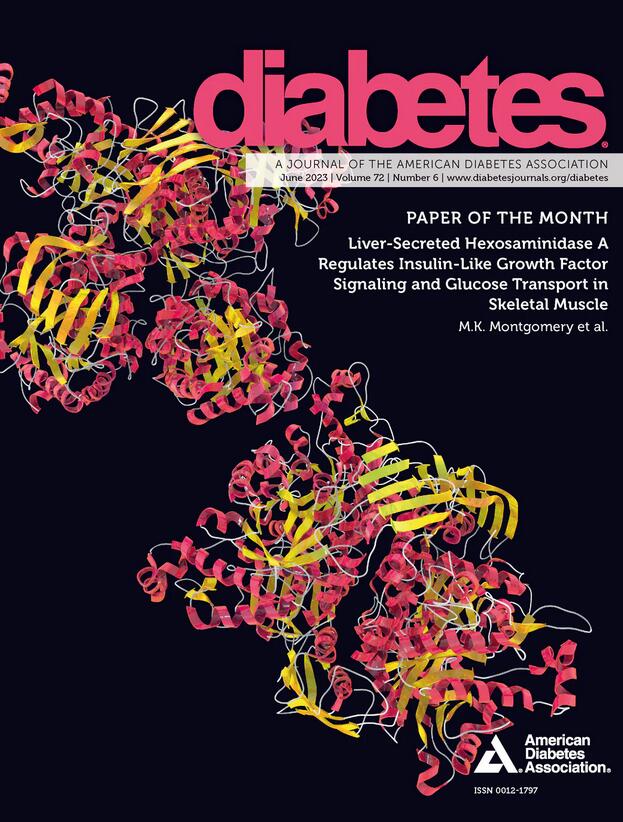研究晚期糖尿病视网膜病变:链脲佐菌素诱导小鼠模型血管变化的长期分析
IF 7.5
1区 医学
Q1 ENDOCRINOLOGY & METABOLISM
引用次数: 0
摘要
糖尿病视网膜病变(DR)的特点是微血管损伤和视网膜血管通透性增加。对于晚期DR的视力结果的研究受到维持慢性高血糖小鼠的挑战的限制,并且大多数报道仅限于早期DR。在本研究中,我们使用精心管理的糖尿病小鼠来纵向研究早期和晚期DR中血管渗漏与视力之间的关系。采用双荧光血管造影(FA-DF)观察慢性高血糖小鼠视网膜血管渗漏动态。视网膜血管渗漏在糖尿病诱导后180天明显,在视力下降之前,使用光动力学反应测量,血管渗漏在DR进展中继续增加。在DR晚期,小鼠也接受玻璃体内注射抗血管生成阿布西普,用FA-DF可靠地测量渗漏减少,并与视力改善有关。使用免疫染色评估炎症和血管表型,结果显示与年龄匹配的糖尿病对照组相比,抗vegf治疗显著降低了视网膜巨噬细胞和血管密度,减少了毛细血管直径。总之,这是第一次在同一组小鼠中以微创方式对DR早期、中期和晚期的视网膜血管渗漏进行纵向量化,以证明体内抗血管生成治疗的相关作用。我们的研究结果还进一步证实了FA-DF在评估视网膜血管渗漏时的敏感性,并在同一动物的纵向研究中结合其他功能测量。我们使用新开发的荧光血管造影双荧光成像方法,纵向研究糖尿病小鼠早期、中期和晚期糖尿病视网膜病变(DR)期间血管渗漏与视力之间的关系。我们证实了血管渗漏的发生和进展,渗漏与视力下降的关系,以及晚期DR中巨噬细胞和血管密度的改变。我们在同一动物的纵向研究中证实了荧光血管造影术与其他功能测量相结合评估视网膜血管渗漏的敏感性,并证实了晚期DR中的炎症变化。本文章由计算机程序翻译,如有差异,请以英文原文为准。
Investigating Late-Stage Diabetic Retinopathy: A Long-term Analysis of Vascular Changes in the Streptozotocin-Induced Mouse Model
Diabetic retinopathy (DR) is characterized by microvascular damage and increased vascular permeability in the retina. The investigation of visual outcomes in late-stage DR is limited by challenges of maintaining chronically hyperglycemic mice, and most reports are restricted to early-stage DR. In this study, we used carefully managed diabetic mice to longitudinally investigate associations between vascular leakage and visual acuity during early- and late-stage DR. Diabetes was induced in C57BL/6J mice with streptozotocin, and fluorescence angiography with dual fluorescence (FA-DF) was used to assess retinal vascular leakage dynamics in chronically hyperglycemic mice for 12 months. Retinal vascular leakage was evident 180 days after diabetes induction and before reduced visual acuity, measured using the optokinetic response, and vascular leakage continued to increase during DR progression. Mice were also treated with intravitreal injections of antiangiogenic aflibercept at late-stage DR, and reduced leakage was reliably measured using FA-DF and was associated with improved visual acuity. Inflammatory and vascular phenotypes were assessed using immunostaining, which revealed significantly lower retinal macrophage and vascular densities and reduced capillary diameter in association with anti-VEGF treatment compared with age-matched diabetic controls. In conclusion, this is the first longitudinal quantification of retinal vascular leakage in early, intermediate, and late stages of DR in the same cohort of mice in a minimally invasive fashion to demonstrate the associated effect of antiangiogenic therapy in vivo. Our findings also further confirmed the sensitivity of FA-DF in assessing retinal vascular leakage in conjunction with other functional measures in longitudinal studies in the same animals. ARTICLE HIGHLIGHTS We use the newly developed fluorescence angiography with dual fluorescence imaging method to longitudinally investigate associations between vascular leakage and visual acuity during early-, intermediate-, and late-stage diabetic retinopathy (DR) in diabetic mice. We demonstrate the onset and progression of vascular leakage, association of leakage with reduced visual acuity, and alteration of macrophage and vascular densities in late-stage DR. We confirm the sensitivity of fluorescence angiography with dual fluorescence in assessing retinal vascular leakage in conjunction with other functional measures in longitudinal studies in the same animals and demonstrate inflammatory changes in late-stage DR.
求助全文
通过发布文献求助,成功后即可免费获取论文全文。
去求助
来源期刊

Diabetes
医学-内分泌学与代谢
CiteScore
12.50
自引率
2.60%
发文量
1968
审稿时长
1 months
期刊介绍:
Diabetes is a scientific journal that publishes original research exploring the physiological and pathophysiological aspects of diabetes mellitus. We encourage submissions of manuscripts pertaining to laboratory, animal, or human research, covering a wide range of topics. Our primary focus is on investigative reports investigating various aspects such as the development and progression of diabetes, along with its associated complications. We also welcome studies delving into normal and pathological pancreatic islet function and intermediary metabolism, as well as exploring the mechanisms of drug and hormone action from a pharmacological perspective. Additionally, we encourage submissions that delve into the biochemical and molecular aspects of both normal and abnormal biological processes.
However, it is important to note that we do not publish studies relating to diabetes education or the application of accepted therapeutic and diagnostic approaches to patients with diabetes mellitus. Our aim is to provide a platform for research that contributes to advancing our understanding of the underlying mechanisms and processes of diabetes.
 求助内容:
求助内容: 应助结果提醒方式:
应助结果提醒方式:


